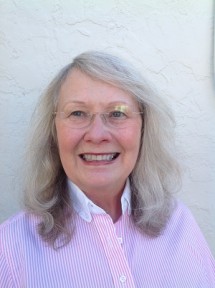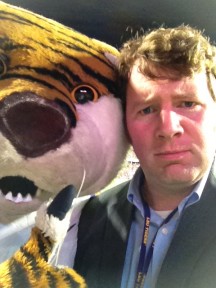By Clancy Crismore
The first dean of the University of Montana’s journalism school, Arthur L. Stone, borrowed tents from Fort Missoula and pitched them on the Oval to hold classes. It was the fall of 1914, and 16 students took Stone’s offer to brave the elements in return for learning the newspaper trade.
Beginning in September 2014, the journalism school will celebrate a century of practical education that has prepared journalists to work in the professional world. The centennial-themed lectures, reunions, projects, and celebrations will span the entire school year.
Interim Dean Denise Dowling said the Montana Broadcasters Association is sponsoring student video productions, and students will produce a print publication as well.
In addition to the work produced by current students, the Homecoming alumni party promises to be a highlight.
“We want everyone to come,” said Lee Banville, who is spearheading the event planning with his wife and fellow journalism professor Jule Banville. “What’s daunting is creating an event that everyone will want to go back to.”
As alumni come pouring back to the school, Dowling hopes some will contribute to scholarships and student projects like Native News.
These projects embody the hands-on learning that Stone envisioned for the school.
“We are not aiming to graduate young men and women who will enter newspaper offices with the idea that they will upset traditions and shatter precedents,” Stone wrote to a colleague, “but to send to these offices workers who will know what to do and how to do it, when they are given an assignment.”
But over the years, some graduates have exceeded Stone’s modest expectations and achieved a level of prestige beyond what any school could teach.
SHANE BISHOP (1986) is an award-winning producer for NBC’s “Dateline” and will soon mark his 20th year with the program.
“Listen. Ditch your ego. Ask stupid questions. Nothing else matters if you mess up the facts. Write, then rewrite. And rewrite again. Take advice. If anyone — even the janitor — comes up with an idea that makes your work better, use it. Give voice to victims. Ac- knowledge what others have endured. Be nice, even when you’re in a hurry. And as my dad, a small-town editor, always said, ‘Keep at it. Keep at it. Keep at it.’”
DANNY DAVIS (2007) is a native of Billings. After graduating, he moved to Austin, Texas, and now writes for the Austin-American Statesman as a sports reporter covering high school athletics and occasional University of Texas sporting events.
“You have to be willing to do any- thing, and you have to find ways to make yourself stand out in the newsroom. I was producing a daily blog and working on social media sites and that helped me stand out. Don’t get frustrated going in. Be patient and be flexible.”
KAY ELLERHOFF (1967) spent 20 years as the associate editor for Montana Outdoors magazine and 10 years as executive editor for W.O.W (Wild Outdoor World). She currently works as a freelance editor.
1. Attend or tune in to conferences, seminars, or webinars where you can discuss your notes, successes, or difficulties.
2. Never stop improving your skills. No matter how long you’ve been wielding a red pencil and in whatever form, your skills can always be updated and improved.
3. Read articles from publications carefully and conscientiously edited by wise, careful, and conscientious editors.”
KEVIN VAN VALKENBURG (2000) worked as a beat reporter for The Baltimore Sun before becoming a feature writer. He currently writes for ESPN the Magazine and ESPN.com.
1. Read constantly.
2. Understand the difference be- tween confidence and arrogance.
3. Seek out mentors. You don’t know who is going to open a door for you down the road.
4. Have a word document or a notebook you’re constantly trying to fill with ideas.
5. Be willing to sacrifice, willing to take risks, and willing to give up certain things to chase your dream.”
HOLLY PICKETT (2002) worked as a staff photographer at The Spokesman-Review newspaper in Spokane, Washington, from 2002-2007, before moving to Cairo, Egypt, to pursue freelance photojournalism. She has worked all over the Middle east, Africa, and Central Asian and her work has appeared in various publications such as The New York Times, The New Yorker, Time, and many more.
“Never stop learning. You have to keep your curiosity about the world around you and keep growing, both as a person and as a journalist. And you have to believe that what we do matters. It will help you through the rough patches in this- at times chaotic- life’s calling. To help me along the way, I learned (and continue to learn) a tremendous amount from my colleagues. I’ve been lucky to find a network of mentors, collaborators, and friends without whom I wouldn’t be where I am.”
MEG OLIVER BASINGER (1993) currently works for ABC News. Prior to that, she worked for three years as the anchor for the CBS newscast “Up to the Minute.” She also worked as a reporter and anchor for various TV stations throughout the country.
“Be geographically flexible; go anywhere for that first job, from Alaska to Alabama. Explore and enjoy the adventure before you settle down. I lived in nine states before landing at the network and every stop opened my eyes to a different part of the country. It made me a better reporter and anchor, especially on election night. Be a team player. You can’t get on TV without the masterminds behind the screen- translation: Don’t be a diva. And finally, if you want to stand out, separate yourself from the pack. Don’t settle for the soundbite everyone has. Keep digging until you find something new and fresh.”











